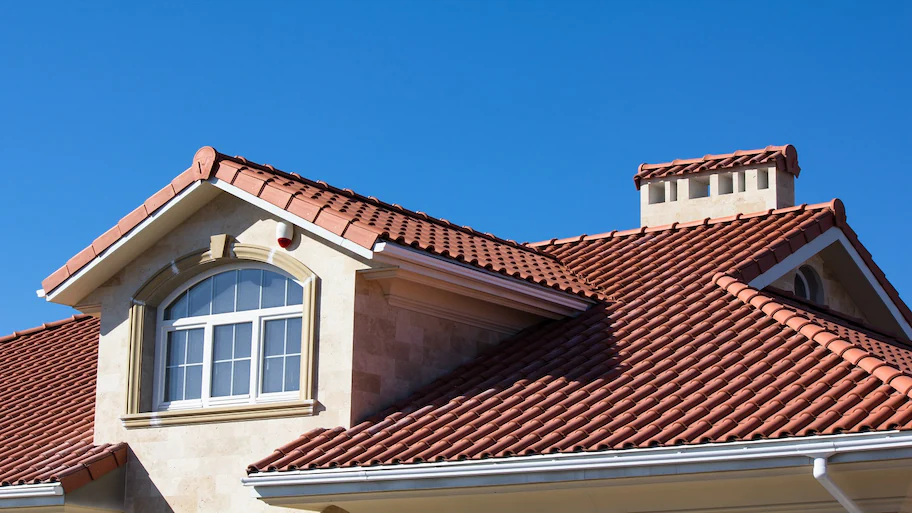
A new roof improves curb appeal, increases home value and keeps your living space protected from the elements. Learn about average roof replacement costs to set your budget.
Know your roof from every angle


Roof pitch is the vertical rise for every 12 inches of horizontal run.
You can calculate roof pitch from the roof, the attic, or the ground.
You can hire a roofing pro to measure it for you.
Whether you're building a new home or addition, installing a new roof, or remodeling your home, you’ll need to know how to calculate roof pitch. Knowing your roof pitch is also helpful when estimating roof replacement or roof truss costs. This guide will teach you how to calculate roof pitch to plan your construction project successfully.
Roof pitch measures how much your roof rises vertically for every 12 inches of horizontal run. The greater the vertical rise, the steeper the pitch. Knowing your roof pitch helps you determine the type and amount of roofing material you need when you’re repairing or replacing your roof.
Below are some common roof pitches and their ratios.
| Pitch Type | Pitch Ratio | Pitch Percentage | Common In |
|---|---|---|---|
| Low | 3:12–4:12 | 25%–33% | Modern or commercial buildings |
| Medium | 5:12–7:12 | 42%–58% | Residential homes |
| Steep | 8:12–12:12 | 67%–100% | Historic or Tudor-style homes |
To calculate roof pitch, you need to know how many vertical inches your roof gains for every foot of horizontal run using the following calculation:
Roof pitch = Rise (inches) / 12 inches
For example, a roof that rises vertically by 5 inches every 12 inches of horizontal run has a 5:12 pitch. You can also express pitch in degrees, like so:
Roof pitch = Rise (inches) / 12 inches X 100
For example, a roof with a 5:12 pitch would equal 42%.
The three main ways to measure room pitch are from the top of the roof, the attic, and the ground. Here’s how to calculate roof pitch using each of these three methods.
If you plan to measure roof pitch from the roof, take the proper safety precautions. You’ll need a sturdy ladder and fall protection equipment to prevent serious injuries. Once you’re properly secured and on the roof, grab a 12-inch level and a tape measure.
Place the level flat on the roof’s surface and use your tape measure to determine the roof’s rise to the level’s 12-inch mark. If you measure a vertical rise of 5 inches, your roof’s pitch is 5:12 or 42%.
You can also calculate your roof pitch from inside the attic. This is the safer option and doesn’t require ladders or safety equipment.
To measure roof pitch from inside the attic, place the level on top of a ceiling joist and ensure it’s completely level. Then, measure the distance between the 12-inch mark of the level and the roof. That will give you the roof pitch.
For example, if you measure 4 inches from the level to the roof, the pitch is 4:12 or 33%.
Measuring roof pitch from the ground using a pitch gauge or an app is also possible.
To measure roof pitch from the ground, point the pitch gauge at the roof and align it with the slope. The gauge should show you the exact pitch of your roof. You can also find apps to do this if you don’t want to buy a gauge. These apps work similarly; you just align them with the roof slope, and they’ll tell you the pitch.
Although it’s possible to measure roof pitch yourself, you might prefer to hire a roofing pro—especially if you’re measuring pitch from on top of the roof or have a complex roof with numerous pitches. A roofing professional near you will have the right equipment and experience to measure your roof gauge and recommend the type and amount of roofing materials you need.
From average costs to expert advice, get all the answers you need to get your job done.

A new roof improves curb appeal, increases home value and keeps your living space protected from the elements. Learn about average roof replacement costs to set your budget.

Raising the roof on a Cape Cod house adds valuable living space. Learn how much it costs to raise the roof on a Cape Cod house and what affects the price.

Getting a wind mitigation inspection can work in your financial favor. Learn about the average wind mitigation inspection cost, including ways to save.

There is a calculation for how many soffit vents you need, depending on your square footage. Discover where to install them and what happens to your attic air during winter.

If you need a new flat roof, learn about tar and gravel roof costs and what can affect your total to make sure you budget accurately.

Hiring a reputable roofing company is the key to a safe and long-lasting roof. Here are the top questions to ask a roofer before hiring the best professional.